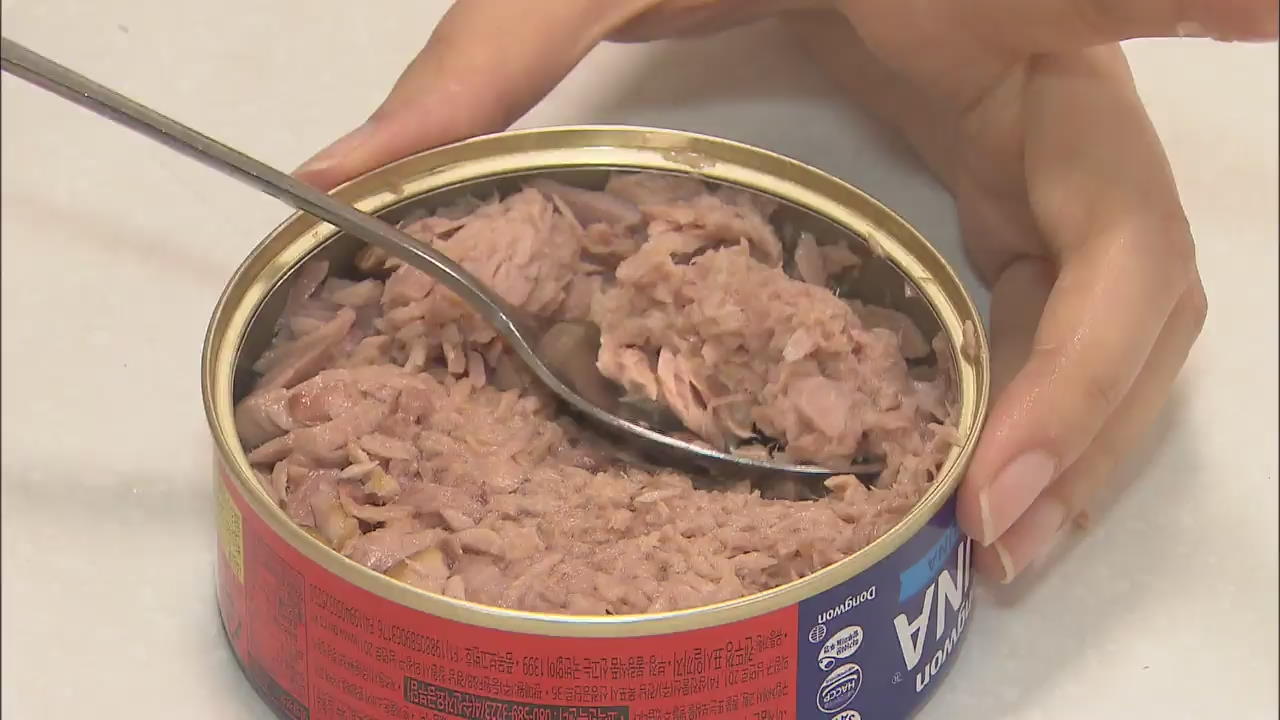Fish Intake Standards
입력 2017.06.23 (14:08)
수정 2017.06.23 (14:19)
읽어주기 기능은 크롬기반의
브라우저에서만 사용하실 수 있습니다.
[Anchor Lead]
Fish is good for your body, especially when it comes to brain development, but heavy metals accumulated in fish are a big concern. Now the Korean public health authority has presented for the first time detailed intake standards on which fish are safe to eat and how much.
[Pkg]
This is tuna, called the aristocrat of the sea for its great taste and high nutrition. Bluefin tuna, which lives in the deep sea is usually eaten raw...while the skipjack tuna found near the surface is canned. The amount of mercury accumulated in the fish varies by their habitats and sizes. In general, tuna eaten raw contains ten times more mercury than the tuna headed to the cannery. Because of the dangers of heavy metals in fish, people are concerned about which fish to eat and how much.
[Soundbite] Joo Seon-yeong(Seoul Resident) : "I was concerned because my children are little, but there weren't any special guidelines or information."
The Ministry of Food and Drug Safety recommends that infants and toddlers under two years of age, who react sensitively to mercury intake, should avoid raw tuna and other deep-sea fish. However, baby food made with canned tuna is safe to eat. Consuming about 15 grams or a tablespoon of canned tuna daily would do them no harm. As for pre-school children, their weekly tuna intake should be limited to 40 grams or less. Pregnant women should be careful with their tuna consumption as well, because heavy metals in fish could affect the development of the nervous system in fetuses or infants. They should eat fewer than 100 grams of tuna once a week. However, canned tuna with markedly lower mercury contents and other fish are safe for pregnant women and children to eat.
[Soundbite] Sohn Seong-wan(Ministry of Food and Drug Safety) : "The amount of methylmercury is very safe since it is only 5% of the safety allowance level."
The Ministry of Food and Drug Safety recommends that adolescents and grownups should eat fish, as it is a food source rich in protein and omega-3 fatty acid.
Fish is good for your body, especially when it comes to brain development, but heavy metals accumulated in fish are a big concern. Now the Korean public health authority has presented for the first time detailed intake standards on which fish are safe to eat and how much.
[Pkg]
This is tuna, called the aristocrat of the sea for its great taste and high nutrition. Bluefin tuna, which lives in the deep sea is usually eaten raw...while the skipjack tuna found near the surface is canned. The amount of mercury accumulated in the fish varies by their habitats and sizes. In general, tuna eaten raw contains ten times more mercury than the tuna headed to the cannery. Because of the dangers of heavy metals in fish, people are concerned about which fish to eat and how much.
[Soundbite] Joo Seon-yeong(Seoul Resident) : "I was concerned because my children are little, but there weren't any special guidelines or information."
The Ministry of Food and Drug Safety recommends that infants and toddlers under two years of age, who react sensitively to mercury intake, should avoid raw tuna and other deep-sea fish. However, baby food made with canned tuna is safe to eat. Consuming about 15 grams or a tablespoon of canned tuna daily would do them no harm. As for pre-school children, their weekly tuna intake should be limited to 40 grams or less. Pregnant women should be careful with their tuna consumption as well, because heavy metals in fish could affect the development of the nervous system in fetuses or infants. They should eat fewer than 100 grams of tuna once a week. However, canned tuna with markedly lower mercury contents and other fish are safe for pregnant women and children to eat.
[Soundbite] Sohn Seong-wan(Ministry of Food and Drug Safety) : "The amount of methylmercury is very safe since it is only 5% of the safety allowance level."
The Ministry of Food and Drug Safety recommends that adolescents and grownups should eat fish, as it is a food source rich in protein and omega-3 fatty acid.
■ 제보하기
▷ 카카오톡 : 'KBS제보' 검색, 채널 추가
▷ 전화 : 02-781-1234, 4444
▷ 이메일 : kbs1234@kbs.co.kr
▷ 유튜브, 네이버, 카카오에서도 KBS뉴스를 구독해주세요!
- Fish Intake Standards
-
- 입력 2017-06-23 14:05:48
- 수정2017-06-23 14:19:15

[Anchor Lead]
Fish is good for your body, especially when it comes to brain development, but heavy metals accumulated in fish are a big concern. Now the Korean public health authority has presented for the first time detailed intake standards on which fish are safe to eat and how much.
[Pkg]
This is tuna, called the aristocrat of the sea for its great taste and high nutrition. Bluefin tuna, which lives in the deep sea is usually eaten raw...while the skipjack tuna found near the surface is canned. The amount of mercury accumulated in the fish varies by their habitats and sizes. In general, tuna eaten raw contains ten times more mercury than the tuna headed to the cannery. Because of the dangers of heavy metals in fish, people are concerned about which fish to eat and how much.
[Soundbite] Joo Seon-yeong(Seoul Resident) : "I was concerned because my children are little, but there weren't any special guidelines or information."
The Ministry of Food and Drug Safety recommends that infants and toddlers under two years of age, who react sensitively to mercury intake, should avoid raw tuna and other deep-sea fish. However, baby food made with canned tuna is safe to eat. Consuming about 15 grams or a tablespoon of canned tuna daily would do them no harm. As for pre-school children, their weekly tuna intake should be limited to 40 grams or less. Pregnant women should be careful with their tuna consumption as well, because heavy metals in fish could affect the development of the nervous system in fetuses or infants. They should eat fewer than 100 grams of tuna once a week. However, canned tuna with markedly lower mercury contents and other fish are safe for pregnant women and children to eat.
[Soundbite] Sohn Seong-wan(Ministry of Food and Drug Safety) : "The amount of methylmercury is very safe since it is only 5% of the safety allowance level."
The Ministry of Food and Drug Safety recommends that adolescents and grownups should eat fish, as it is a food source rich in protein and omega-3 fatty acid.
Fish is good for your body, especially when it comes to brain development, but heavy metals accumulated in fish are a big concern. Now the Korean public health authority has presented for the first time detailed intake standards on which fish are safe to eat and how much.
[Pkg]
This is tuna, called the aristocrat of the sea for its great taste and high nutrition. Bluefin tuna, which lives in the deep sea is usually eaten raw...while the skipjack tuna found near the surface is canned. The amount of mercury accumulated in the fish varies by their habitats and sizes. In general, tuna eaten raw contains ten times more mercury than the tuna headed to the cannery. Because of the dangers of heavy metals in fish, people are concerned about which fish to eat and how much.
[Soundbite] Joo Seon-yeong(Seoul Resident) : "I was concerned because my children are little, but there weren't any special guidelines or information."
The Ministry of Food and Drug Safety recommends that infants and toddlers under two years of age, who react sensitively to mercury intake, should avoid raw tuna and other deep-sea fish. However, baby food made with canned tuna is safe to eat. Consuming about 15 grams or a tablespoon of canned tuna daily would do them no harm. As for pre-school children, their weekly tuna intake should be limited to 40 grams or less. Pregnant women should be careful with their tuna consumption as well, because heavy metals in fish could affect the development of the nervous system in fetuses or infants. They should eat fewer than 100 grams of tuna once a week. However, canned tuna with markedly lower mercury contents and other fish are safe for pregnant women and children to eat.
[Soundbite] Sohn Seong-wan(Ministry of Food and Drug Safety) : "The amount of methylmercury is very safe since it is only 5% of the safety allowance level."
The Ministry of Food and Drug Safety recommends that adolescents and grownups should eat fish, as it is a food source rich in protein and omega-3 fatty acid.
이 기사가 좋으셨다면
-
좋아요
0
-
응원해요
0
-
후속 원해요
0

















이 기사에 대한 의견을 남겨주세요.